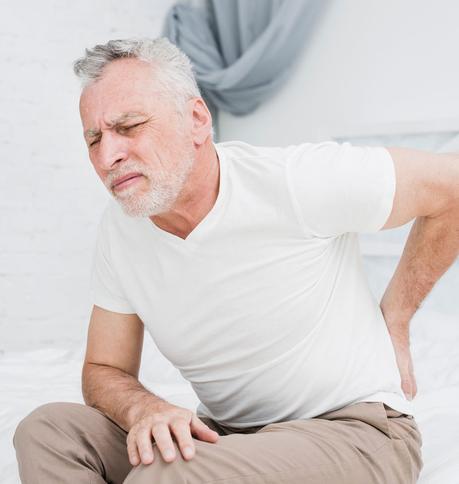Chronic pain (persistent pain) lasts longer than three months.
Whereas pain is a normal sensation that alerts us to possible injury, chronic pain is very different. Chronic pain signals remain active for months or years after wound healing.
Persistent pain can occur anywhere in your body. It is a very personal experience; it can be mild or severe, episodic or continuous. It can sometimes interfere with your activities of daily living, including relationships with family and friends. Chronic pain is often accompanied by other health concerns, such as feeling tired, frustrated, anxious or sad.

Chronic pain can happen for many reasons, including after surgery, an injury, or another condition. This information is about persistent pain that is not caused by cancer.
Chronic or persistent pain lasts over three months, or in many cases, beyond the average healing time. It differs from acute pain, such as pain from an injury, which develops quickly and doesn’t usually last long. Persistent pain can happen for many reasons, including after surgery, an injury, or another condition. This information is about constant pain that is not caused by cancer.
Chronic pain is a complex condition, and everyone experiences it differently. The pain can range from mild to severe and is shared most days.
Most pain goes away. You recover from surgery. Your toothache gets treated. Your sprained ankle heals. That occasional headache responds to aspirin. These are examples of acute, or temporary, pain. Persistent pain is pain that won’t go away, lasting three months or longer. Examples include arthritis in your knees, back, or neck that hurts most days; frequent migraine headaches; surgical pain that isn’t appropriately treated and lingers; and pain from muscle injuries that don’t heal correctly.
What Causes Chronic Pain?
There are different types of chronic pain, including nerve pain, pain caused by a bone, muscle or joint condition, and pain due to cancer.
Persistent pain can also be caused by illnesses such as migraine, osteoporosis, arthritis and other musculoskeletal conditions, or after an injury or surgery. Sometimes there is no apparent cause of chronic pain.
Usually, if you have an injury, nerves carry signals from the injured part of your body to the brain, telling the brain that there’s a problem. The brain reads these signals as pain.
But when someone has persistent pain, the nerves that carry pain signals to the brain, or the brain itself, behave unusually. The nerves might be more sensitive than usual, or the brain might be misreading other signals as pain.
Other common causes of chronic pain are:
- Past injuries or surgeries
- Back and neck injuries
- Fibromyalgia and musculoskeletal pain, a condition in which people feel muscle pain throughout their bodies
- An old injury
- Phantom limb pain
- Infections
- Arthritis
- Nerve damage
- Cancer
Acute pain can develop into a chronic condition if left untreated or if the acute pain is poorly treated. The more prolonged pain remains untreated, the greater the risk of pain becoming chronic.
If you are concerned about your pain, talk to your doctor.

What Are The Symptoms of Chronic Pain?
Chronic pain can range from mild to severe. It can continue day after day or come and go. The pain can feel like:
- A dull ache
- Throbbing
- Burning
- Shooting
- Squeezing
- Stinging
- Soreness
- Stiffness
Chronic pain can affect almost all parts of your life. Your sleep, mood, activity, and energy level can all be disrupted by pain. Being tired, depressed, and out of shape can make the pain worse and harder to cope with.
Pain isn’t just physical. Persistent pain affects the body, but it also affects emotions, relationships, and the mind. It can cause anxiety and depression, which, in turn, can make the pain worse. The urge to stop the pain can make some people dependent on medicines. It may cause others to have repeated surgeries or try questionable treatments. This can often be as hard on the family as on the person with the pain.
Carpal Tunnel Syndrome Postural Dysfunction ScoliosisChronic Pain Treatment
Chronic pain treatment aims to help you manage your pain, achieve what you want to do, get pleasure from life and be as healthy as possible. Several different treatment options have been proven to improve persistent pain, including:
- Self-management education
Chronic Pain education is the foundation of all pain treatments. It provides you with an understanding of how persistent pain works in your body and will give you techniques to deal with the impact of pain in your life, including:
Frustrations, exercising, nutrition, pacing activity, and how to evaluate which treatment options are best for you.
- Injections
These include steroid injections.
Heat and cold treatments
These can reduce stiffness and pain, especially with joint problems such as arthritis.

Physical Therapy and Exercise
Exercise can have a positive effect on pain relief. Combining general aerobics (walking, stationary bicycle), strengthening, and flexibility exercises are most beneficial. A physical therapist can help you set goals and recommend exercises to improve your movement and functioning. This involves different treatments, such as exercises and stretching. These can help reduce certain types of persistent pain.
Occupational Therapy
This teaches you how to do routine tasks of daily living in ways that can help reduce your pain.
Local electrical stimulation
Short pulses of electricity on nerve endings under the skin give pain relief.
Counselling
It is common for people with chronic pain to experience frustrations, depression, anxiety, and mood changes. This can make it harder to manage your chronic pain. A counselor may use treatments such as Cognitive Behavioural Therapy, Mindfulness-Based Stress Reduction, and Acceptance and Commitment Therapy (ACT) to help you cope with your pain.
Other therapies
Meditation, yoga, biofeedback, and massage can also help manage chronic pain. Medications can sometimes help with persistent pain but are not a cure. Drugs work best when they are used along with other types of treatment, including counseling and physical therapy.
Pain is Difficult. Let Us Help—your Partner with Pain Relief. Call & Book Today! Better Health Naturally. Call Us Today. Schedule an Appointment Now.

